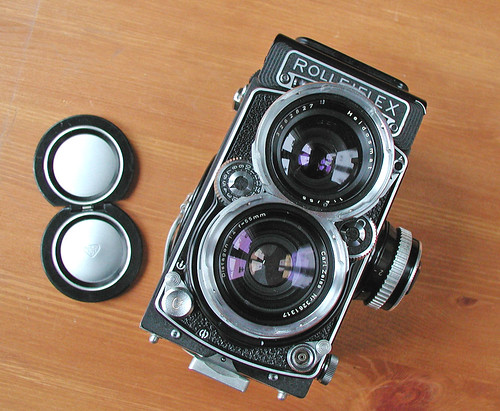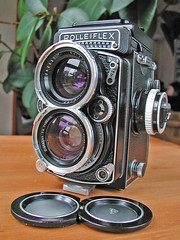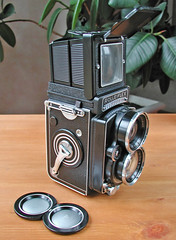Wide-Angle Rolleiflex
Revision as of 08:13, 17 January 2021 by Hanskerensky (talk | contribs) (Added link to user manual page)

|
| Wide-Angle Rolleiflex image by Yannick Michel (Image rights) |
The Wide-Angle Rolleiflex is a medium format Wide-angle TLR camera manufactured by Franke & Heidecke and later on by Rollei.
Contents
General
The Wide-Angle Rolleiflex was Rolleis answer to the growing demand for a Rolleiflex with a wide-angle lens.
This choice to design and produce a wide-angle TLR was furthermore induced by the appearance of the Mamiya C serie of TLR's which feature interchangeable lenses.
In fact Rollei did design a prototype with 3 interchangeable lenses but decided that the needed extra mechanisms did lower the handling capacities too much.
It is designed using the Rolleiflex E as a base.
There were 2 models manufactured :
- Model 1 from 1961 to 1965
- Model 2 from 1965 to 1967, which could handle both 120 and 220 film rolls.
35 years after the end of the production Rollei introduced a follow-up, the Rolleiflex 4.0 FW.
Specifications
- Format : 12 exposures of 6 x 6 cm on 120 type rollfilm.
Model 2 also 220 type rollfilm (24 exposures of 6 x 6cm).
Furthermore a Plate adapter for sheet film and a Rolleikin adapter for 35mm film cartridges can be used. - Taking lens: Carl Zeiss Oberkochen Distagon 1:4 f=55mm.
- Viewing lens: Heidosmat 1:4 f=55mm.
- Filter Bayonet : Both lenses, size 4.
- Shutter: Synchro-Compur MXV CR0 leafshutter. Speeds 1 to 1/500 sec. and B. Selftimer.
- Flash synchronisation : Synch socket on front panel, M and X synchronisation.
- Lighmeter system : Optional, coupled, Selenium photo element, 2 ranges.
- Dimensions WxDxH: 128 x 113 x 152 mm
- Weight: 1355 grams
  
|
| Wide-Angle Rolleiflex. Images by Yannick Michel. (Image rights) |
Bibliography
- Claus Prochnow, Rollei Report 2, third edition, Braunschweig, Lindemanns Verlag, 2008, ISBN 3-89506-220-0.